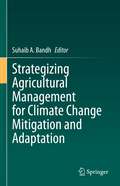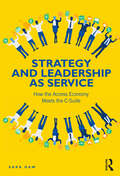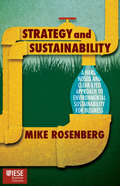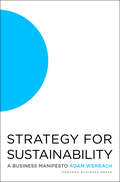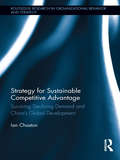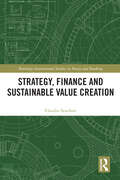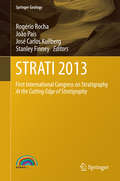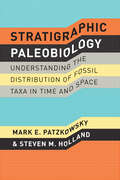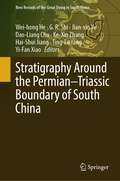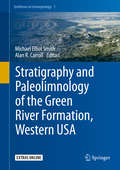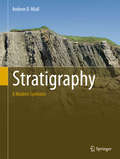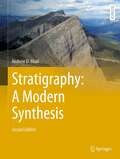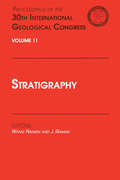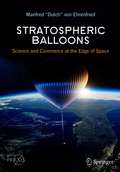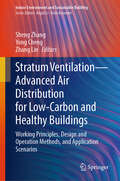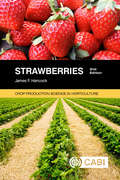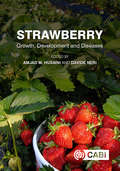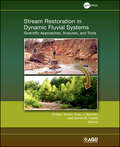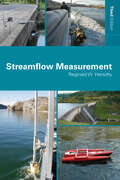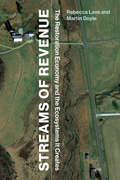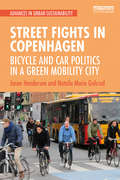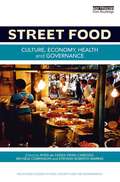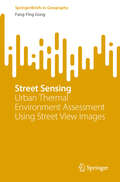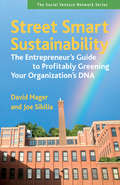- Table View
- List View
Strategizing Agricultural Management for Climate Change Mitigation and Adaptation
by Suhaib A. BandhThis volume aims to raise awareness and stimulate research on how agricultural management could help to mitigate climate change impacts, and focuses on technical progressions and innovations in climate change mitigation and adaptation. It addresses new innovations in agricultural technology and management with the goal of balancing agricultural production and its associated climate effects in a sustainable manner. The major topics covered include crop and soil management, techniques and technologies for emission reduction, irrigation, land degradation, pest and disease management, farmers' perspectives, and climate-smart agriculture policy. The book is geared towards students, researchers, and professionals in the fields of environmental science, agriculture science, and climate change.
Strategy and Leadership as Service: How the Access Economy Meets the C-Suite
by Sara DawStrategy and Leadership as Service isn’t just a nice idea; it is a practical, alternative vision of the future of work for senior executives that is starting to gain significant interest and is being adopted by businesses globally. Disrupting and challenging the traditional full-time employment model, the Strategy and Leadership as Service framework provides businesses with access to the complete range of functional, emotional, and collective intelligence at the C-suite level by moving their positions from the “pay-roll” to an “access-role.”Many entrepreneurial and growing businesses don’t need, don’t want, and can’t afford full-time C-suite executives. For larger organisations, it is becoming harder to find the skills and knowledge required to fulfil all the obligations of a functional C-suite with a fixed group of individuals. By moving to the Strategy and Leadership as Service framework, the outcomes are better for all stakeholders: more engagement, access to the right skillsets and mindsets at the right time and in the right quantity to match the changing business agenda, more flexibility for senior leaders, and strengthened risk management. Through presenting a working business model, and real-world case studies throughout, this book provides executives and leaders with a complete understanding of this ground-breaking approach and its key benefits, the theory upon which it is based, its essential ingredients, the mindset change required and, most importantly, how to apply it in practice.The book provides business leaders, C-suite portfolio executives, human resource professionals, strategy consultants, leadership coaches, organisational development consultants, recruiters, professional service firms, academics, and forward-thinking business students with a radical new view of how the access economy can be applied to business strategy and leadership for more sustainable futures.
Strategy and Sustainability: A Hardnosed and Clear-Eyed Approach to Environmental Sustainability For Business (IESE Business Collection)
by Mike RosenbergBusiness and environmental sustainability are not natural bedfellows. Business is about making money; sustainability is about protecting the planet. Business is measured in months and quarters; sustainability often requires significant short term costs to secure a sometimes uncertain long-term benefit. To some activists, all executives are exploitative, selfish “1 percenters”. To some executives, all activists are irresponsible, unyielding extremists.And yet engaging with the issue isn’t optional – all businesses must have a strategy to deal with sustainability and, like any strategy, this involves making choices. Strategy and Sustainability encourages its readers to filter out the noise and make those choices in a hard-nosed and clear-eyed way. Rosenberg’s nuanced and fact-based point of view recognizes the complexity of the issues at hand and the strategic choices businesses must make. He blends the work of some of the leading academic thinkers in the field with practical examples from a variety of business sectors and geographies and offers a framework with which Senior Management might engage with the topic, not (just) to save the planet but to fulfil their short, medium, and long-term responsibilities to shareholders and other stakeholders.
Strategy for Sustainability
by Adam WerbachThe definitive work on business strategy for sustainability by the most authoritative voice in the conversation.More than ever before, consumers, employees, and investors share a common purpose and a passion for companies that do well by doing good. So any strategy without sustainability at its core is just plain irresponsible - bad for business, bad for shareholders, bad for the environment. These challenges represent unprecedented opportunities for big brands - such as Clorox, Dell, Toyota, Procter & Gamble, Nike, and Wal-Mart - that are implementing integral, rather than tangential, strategies for sustainability. What these companies are doing illuminates the book's practical framework for change, which involves engaging employees, using transparency as a business tool, and reaping the rewards of a networked organizational structure.Leave your quaint notions of corporate social responsibility and environmentalism behind. Werbach is starting a whole new dialogue around sustainability of enterprise and life as we know it in organizations and individuals. Sustainability is now a true competitive strategic advantage, and building it into the core of your business is the only means to ensure that your company - and your world - will survive.
Strategy for Sustainable Competitive Advantage: Surviving Declining Demand and China's Global Development (Routledge Research in Organizational Behavior and Strategy)
by Ian ChastonDue to the adverse outcomes of the recent global recession and the public deficit crisis in the USA and Europe, Western companies can expect flattening or declining sales in their domestic markets. They will also face growing competition as Chinese firms seek to block the activities of foreign companies in their domestic market and expand their own operations in overseas markets. Survival and growth for Western companies is unlikely to come from sustaining current business practices based upon utilization of conventional approaches to strategic management; success will depend on exploiting new knowledge to stay ahead of competition. This book examines the strategic issues associated with the entrepreneurial utilization of new knowledge to create innovative products and services, accompanied by the development of leading edge, highly productive internal organizational processes. Through the use of appropriate theories and illustrative case examples, the text is designed to assist managers in Western organizations and business school students understand how to counter the increasing threats that are posed by the globalization of companies from emerging countries such as the BRIC nations.
Strategy, Finance and Sustainable Value Creation (Routledge International Studies in Money and Banking)
by Claudio ScardoviStrategy and finance are generally viewed as two separate subjects. Once regarded with fascination, they have become the subject of strong criticism, the first considered too theoretical and long term to be of any use and the second too speculative and short term to contribute to value creation. This book argues, however, that strategy and finance are in fact value twins, both of which need a thorough overhaul, from their toolkits to their end goals. The author contends that we rely on strategic and financial frameworks that were developed decades ago, but, in an increasingly complex and risky environment, these need to undergo a profound transformation, one that follows an intertwined approach, enabling companies to achieve the twin goals of value creation and sustainability consistently and successfully.The book provides a fresh and innovative view of strategy and finance. It discusses the concept of strategy extensively, examining its history, application, and importance in modern business. It also explores how strategy has evolved and how it can be adapted to better serve companies in a rapidly changing business landscape. The book emphasizes the role of finance in corporate strategy, suggesting that it is a crucial element in achieving sustainable business success, and explores how financial tools and concepts can be integrated with strategic planning to drive growth and value creation. Further, it investigates how strategic and financial planning can be used to manage business risks effectively. Readers are given useful insights via the inclusion of case studies from numerous industries, including corporations, banks, and wealth and asset managers; these real-world examples serve to close the gap between theory and practice.
Strati 2013
by João Pais Rogério Rocha José Carlos Kullberg Stanley FinneyThe 1st International Congress on Stratigraphy (STRATI 2013), hold in Lisbon, 1-7 July 2013, follows the decision to internationalize the conferences previously organized by the French Committee of Stratigraphy (STRATI), the last one of which was held in Paris in 2010. Thus, the congress possesses both the momentum gained from an established conference event and the excitement of being the first International Congress on Stratigraphy. It is held under the auspices of the International Commission on Stratigraphy (IUGS) and it is envisaged that this first congress will lead to others being held in the future. This book includes all papers accepted for oral or poster presentation at the 1st International Congress on Stratigraphy. Papers include a short abstract, main text, figures, tables and references. Each paper has been reviewed by two internationally renowned scientists.
Stratigraphic Paleobiology: Understanding the Distribution of Fossil Taxa in Time and Space
by Steven M. Holland Mark E. PatzkowskyWhether the fossil record should be read at face value or whether it presents a distorted view of the history of life is an argument seemingly as old as many fossils themselves. In the late 1700s, Georges Cuvier argued for a literal interpretation, but in the early 1800s, Charles Lyell’s gradualist view of the earth’s history required a more nuanced interpretation of that same record. To this day, the tension between literal and interpretive readings lies at the heart of paleontological research, influencing the way scientists view extinction patterns and their causes, ecosystem persistence and turnover, and the pattern of morphologic change and mode of speciation. With Stratigraphic Paleobiology, Mark E. Patzkowsky and Steven M. Holland present a critical framework for assessing the fossil record, one based on a modern understanding of the principles of sediment accumulation. Patzkowsky and Holland argue that the distribution of fossil taxa in time and space is controlled not only by processes of ecology, evolution, and environmental change, but also by the stratigraphic processes that govern where and when sediment that might contain fossils is deposited and preserved. The authors explore the exciting possibilities of stratigraphic paleobiology, and along the way demonstrate its great potential to answer some of the most critical questions about the history of life: How and why do environmental niches change over time? What is the tempo and mode of evolutionary change and what processes drive this change? How has the diversity of life changed through time, and what processes control this change? And, finally, what is the tempo and mode of change in ecosystems over time?
Stratigraphy Around the Permian–Triassic Boundary of South China (New Records of the Great Dying in South China)
by Wei-Hong He G. R. Shi Ke-Xin Zhang Ting-Lu Yang Jian-Xin Yu Dao-Liang Chu Hai-Shui Jiang Yi-Fan XiaoThis book timely provides high-quality records of 32 PTB sections across different depositional settings from terrestrial to marine facies in South China, including descriptions of lithologies, high-resolution correlation of key boundaries and fossil occurrences at each section. This book also analyzes the patterns and processes of the community and ecosystem evolution over space and through time in the lead to the end-Permian mass extinction, and critically analyzes the mostly debated hypothesis, anoxia and volcanism, which were considered as the causes of mass extinction, based on the data from the studied sections of South China, together with materials from other regions of the world.
Stratigraphy and Paleolimnology of the Green River Formation, Western USA
by Alan R. Carroll Michael Elliot SmithThis volume presents a suite of detailed stratigraphic and sedimentologic investigations of the Eocene Green River Formation of Wyoming, Colorado and Utah, one of the world's foremost terrestrial archives of lacustrine and alluvial deposition during the warmest portion of the early Cenozoic. Its twelve chapters encompass the rich and varied record of lacustrine stratigraphy, sedimentology, geochronology, geochemistry and paleontology. Chapters 2-9 provide detailed member-scale synthesis of Green River Formation strata within the Greater Green River, Fossil, Piceance Creek and Uinta Basins, while its final two chapters address its enigmatic evaporite deposits and ichnofossils at broad, interbasinal scale.
Stratigraphy: A Modern Synthesis
by Andrew D. MiallA Comprehensive review of modern stratigraphic methods. The stratigraphic record is the major repository of information about the geological history of Earth, a record stretching back for nearly 4 billion years. Stratigraphic studies fill out our planet's plate-tectonic history with the details of paleogeography, past climates, and the record of evolution, and stratigraphy is at the heart of the effort to find and exploit fossil fuel resources. Modern stratigraphic methods are now able to provide insights into past geological events and processes on time scales with unprecedented accuracy and precision, and have added much to our understanding of global tectonic and climatic processes. It has taken 200 years and a modern revolution to bring all the necessary developments together to create the modern, dynamic science that this book sets out to describe. Stratigraphy now consists of a suite of integrated concepts and methods, several of which have considerable predictive and interpretive power. The new, integrated, dynamic science that Stratigraphy has become is now inseparable from what were its component parts, including sedimentology, chronostratigraphy, and the broader aspects of basin analysis.
Stratigraphy: A Modern Synthesis (Springer Textbooks in Earth Sciences, Geography and Environment)
by Andrew D. MiallThe updated textbook is intended to serve as an advanced and detailed treatment of the evolution of the subject of stratigraphy from its disparate beginnings as separate studies of sedimentology, lithostratigraphy, chronostratigraphy, etc., into a modern integrated discipline in which all components are necessary. There is a historical introduction, which now includes information about the timeline of the evolution of the components of modern stratigraphy. The elements of the various components (facies analysis, sequence stratigraphy, mapping methods, chronostratigraphic methods, etc.) are outlined, and a chapter discussing the modern synthesis is included near the end of the book, which closes with a discussion of future research trends in the study of time as preserved in the stratigraphic record.
Stratigraphy: Proceedings of the 30th International Geological Congress, Volume 11
by Wang NaiwenThis volume presents the proceedings of Symposium I "Stratigraphy" of the 30th International Geological Congress at Beijing. The proceedings aim to present a view of contemporary geology and should be of interest to researchers in the geological sciences.
Stratospheric Balloons: Science and Commerce at the Edge of Space (Springer Praxis Books)
by Manfred “Dutch” von EhrenfriedStratospheric balloons are powerful tools used to study the Earth and its atmosphere, as well as the greater cosmos beyond. This book describes the science and technology behind modern stratospheric ballooning, along with the surprising ways it has impacted our daily lives.The book takes you through every step of the process, starting with an in-depth introduction to basic balloon types and their uses before delving into balloon construction and mission planning. Along the way, you will learn about the novel technologies that have radically changed these balloons and their ability to launch, control and navigate them over specific ground targets. Next follows an exploration of their incredible applications, including research in atmospheric science, cosmology and astronomy, earth studies, meteorology, and aerobiology, and also commercial capabilities such as Internet networks and high-altitude tourism.The community of scientists, engineers, and entrepreneurs involved in stratospheric ballooning is only ever growing. This book shows you how these national and international efforts have truly soared in recent years, and it will be an enjoyable read for anybody interested in learning more about how science and commerce are conducted in the stratosphere, at the edge of space.
Stratum Ventilation—Advanced Air Distribution for Low-Carbon and Healthy Buildings: Working Principles, Design and Operation Methods, and Application Scenarios (Indoor Environment and Sustainable Building)
by Yong Cheng Sheng Zhang Zhang LinThis book investigates the creation of healthy and thermally comfortable built environments in a low-carbon manner with advanced air distribution, i.e., stratum ventilation. Stratum ventilation efficiently supplies conditioned and clean air to the head level of occupants for thermal comfort and inhaled air quality and largely reduces energy consumption and CO2 emission, e.g., by 44% and 32%, respectively, compared with the conventional air distribution method. This book provides the working principles, performance evaluations methods, design methods, operation methods, and different application scenarios (particularly highlighting airborne infection risk control of respiratory diseases and integrated application with renewable energy) of stratum ventilation, to provide theoretical understandings and technical guidelines of stratum ventilation. The book is intended for undergraduate and graduate students, researchers, and engineers who are interested in cutting-edge technologies of livable and sustainable built environments.
Strawberries (Crop Production Science in Horticulture)
by James HancockThis new and updated edition of a popular text provides a broad, balanced review of the scientific knowledge of strawberries and their cultivation. The worldwide strawberry industry has grown substantially since the original book was published, and methods of culture have undergone extensive modifications. This volume incorporates important changes to the taxonomy of strawberries and new understanding of how its ancestors evolved. It includes coverage of new disease and pest control methods and recent developments in genomic information. These advancements have greatly improved our understanding of how flowering and fruiting is regulated, and will revolutionize the breeding of strawberries. Drawing on extensive research and practical experience, the author presents an essential text that: Includes new content on genomic data, trait genetics, and marker-assisted strategies for varietal improvement. Provides a thorough review of the evolution of the strawberry and the history of strawberry cultivation. Contains an up-to-date comparison of the cultural systems employed across the world and the physiology behind these practices. Presented in full-colour throughout, this is a core guide for academic and professional researchers, breeders and growers, advisors, extension personnel and students of horticulture.
Strawberry
by Amjad M. Husaini Davide NeriMethods of strawberry cultivation have undergone extensive modification and this book provides an up-to-date, broad and balanced scientific review of current research and emerging challenges. Subjects covered range from plant propagation, architecture, genetic resources, breeding, abiotic stresses and climate change, to evolving diseases and their control. These topics are examined in three sections: - Genetics, Breeding and Omics - covering genetic resources, breeding, metabolomics, transcriptomics, and genetic transformation of strawberry. - Cultivation Systems and Propagation - discusses plant architecture, replanting problems and plant propagation techniques. - Disease and Stress Management - deals with traditional and emerging fungal diseases, their diagnosis and modern biocontrol strategies, and biotechnological interventions for dealing with the challenges of climate change. Strawberry: Growth, Development and Diseases is written by an international team of specialists, using figures and tables to make the subject comprehensible and informative. It is an essential resource for academics and industry workers involved in strawberry research and development, and all those interested in the commercial cultivation of strawberries.
Stream Restoration in Dynamic Fluvial Systems: Scientific Approaches, Analyses, and Tools
by Andrew Simon Sean J. Bennett Janine M. CastroPublished by the American Geophysical Union as part of the Geophysical Monograph Series, Volume 194.<P><P>Stream Restoration in Dynamic Fluvial Systems: Scientific Approaches, Analyses, and Tools brings together leading contributors in stream restoration science to provide comprehensive consideration of process-based approaches, tools, and applications of techniques useful for the implementation of sustainable restoration strategies. Stream restoration is a catchall term for modifications to streams and adjacent riparian zones undertaken to improve geomorphic and/or ecologic function, structure, and integrity of river corridors, and it has become a multibillion dollar industry.<P> A vigorous debate currently exists in research and professional communities regarding the approaches, applications, and tools most effective in designing, implementing, and assessing stream restoration strategies given a multitude of goals, objectives, stakeholders, and boundary conditions. More importantly, stream restoration as a research-oriented academic discipline is, at present, lagging stream restoration as a rapidly evolving, practitioner-centric endeavor. The volume addresses these main areas: concepts in stream restoration, river mechanics and the use of hydraulic structures, modeling in restoration design, ecology, ecologic indices, and habitat, geomorphic approaches to stream and watershed management, and sediment considerations in stream restoration. Stream Restoration in Dynamic Fluvial Systems will appeal to scholars, professionals, and government agency and institute researchers involved in examining river flow processes, river channel changes and improvements, watershed processes, and landscape systematics.
Streamflow Measurement
by Reginald W. Herschy�Too little water or too much'? In either case streamflow measurement is crucial. Climate change could significant affect water resources and flood management. Streamflow measurement is necessary for efficient water management.This third edition deals with all the main current methods for measuring the flow in rivers and open channels, in accordanc
Streams of Revenue: The Restoration Economy and the Ecosystems It Creates
by Rebecca Lave Martin DoyleAn analysis of stream mitigation banking and the challenges of implementing market-based approaches to environmental conservation.Market-based approaches to environmental conservation have been increasingly prevalent since the early 1990s. The goal of these markets is to reduce environmental harm not by preventing it, but by pricing it. A housing development on land threaded with streams, for example, can divert them into underground pipes if the developer pays to restore streams elsewhere. But does this increasingly common approach actually improve environmental well-being? In Streams of Revenue, Rebecca Lave and Martin Doyle answer this question by analyzing the history, implementation, and environmental outcomes of one of these markets: stream mitigation banking.
Street Fights in Copenhagen: Bicycle and Car Politics in a Green Mobility City (Advances in Urban Sustainability)
by Jason Henderson Natalie Marie GulsrudWith 29 percent of all trips made by bicycle, Copenhagen is considered a model of green transport. This book considers the underlying political conditions that enabled cycling to appeal to such a wide range of citizens in Copenhagen and asks how this can be replicated elsewhere. Despite Copenhagen’s global reputation, its success has been a result of a long political struggle and is far from completely secure. Car use in Denmark is increasing, including in Copenhagen's suburbs, and new developments in Copenhagen include more parking for cars. There is a political tension in Copenhagen over the spaces for cycling, the car, and public transit. In considering examples of backlashes and conflicts over street space in Copenhagen, this book argues that the kinds of debates happening in Copenhagen are very similar to the debates regularly occurring in cities throughout the world. This makes Copenhagen more, not less, comparable to many cities around the world, including cities in the United States. This book will appeal to upper-level undergraduates and graduates in urban geography, city planning, transportation, environmental studies, as well as transportation advocates, urban policy-makers, and anyone concerned about climate change and looking to identify paths forward in their own cities and localities.
Street Food: Culture, economy, health and governance (Routledge Studies in Food, Society and the Environment)
by Ryzia de Cassia Vieira Cardoso Stefano Roberto Marras MichPrepared foods, for sale in streets, squares or markets, are ubiquitous around the world and throughout history. This volume is one of the first to provide a comprehensive social science perspective on street food, illustrating its immense cultural diversity and economic significance, both in developing and developed countries. Key issues addressed include: policy, regulation and governance of street food and vendors; production and trade patterns ranging from informal subsistence to modern forms of enterprise; the key role played by female vendors; historical roots and cultural meanings of selling and eating food in the street; food safety and nutrition issues. Many chapters provide case studies from specific cities in different regions of the world. These include North America (Atlanta, Philadelphia, Portland, Toronto, Vancouver), Central and South America (Bogota, Buenos Aires, La Paz, Lima, Mexico City, Montevideo, Santiago, Salvador da Bahia), Asia (Bangkok, Dhaka, Penang), Africa (Accra, Abidjan, Bamako, Freetown, Mozambique) and Europe (Amsterdam).
Street Sensing: Urban Thermal Environment Assessment Using Street View Images (SpringerBriefs in Geography)
by Fang-Ying GongCombining publicly available Google Street View (GSV) images with deep learning and radiative transfer models enables researchers to assess urban physical and thermal environments, especially in high-density areas. This book introduces this advanced approach, which provides large-scale, high-accuracy, and high-density measurements of street-level urban features—key to understanding urban radiation balance and thermal dynamics.By leveraging GSV images, this method directly characterizes urban streetscapes, including structural and geometric attributes, allowing for a comprehensive assessment. Moreover, the methods can be applied to any geographical location covered by GSV, making it a low-cost and effective tool for urban studies globally. This is particularly advantageous compared to traditional 3D-GIS models, which may not always be freely available or as extensive in coverage as GSV images.Lessons from Street Sensing provide data-driven insights for urban planning and governance. The accurate mapping of street view factors and solar irradiance helps identify areas with insufficient greenery, excessive or insufficient solar exposure, and other urban environment issues. These insights can help policymakers and urban planners mitigate negative environmental impacts and improve urban living conditions.
Street Smart Sustainability: The Entrepreneur's Guide to Profitably Greening Your Organization's DNA (false)
by David Mager Joe SibiliaGo Green While Making Green You already know why your company should go green. This comprehensive guide tells you how to do it profitably. It details every step of the process—from getting employee buy-in and conducting a current sustainability audit to developing a plan of action and measuring progress. Nuts-and-bolts guidance helps you make continuous, cost-effective improvements and shift the prevailing business culture by infusing green practices into your organization’s very DNA. Through illustrative examples from a wide variety of industries, this book shows how to: • Design sustainable products • Green your facilities • Find green vendors • Use renewable energy • Reduce harmful emissions • Recycle waste products, and more The emphasis is on practicality—stand-alone chapters you can read when you need them and tools you can use to implement change in any area of your organization. enough
Street-by-Street Retrofit: A Future for Architecture (Routledge Research in Architecture)
by Mike McEvoyFor many years, it has been recognised that improving the energy performance of the existing housing stock is vital if energy demand is to be reduced to combat climate change. The art of retrofit is posited as a way forward beyond today’s weak pseudo-Modernist architecture – all that is left – the final echo of Modernism’s original utopian impulse.Central to the book is the presentation of domestic street-by-street retrofit as an issue with technical, financial and societal dimensions. A holistic view of the complex, interacting factors that have held back any advance is interspersed with a historical account of retrofit’s faltering progress over the last 20 years. The crucial challenges that have been encountered are described, including the technological and human factors that urgently need to be addressed. It is suggested that the utopian instincts that propelled early Modernism can be redeployed in finding an approach to retrofit that will pave the way towards a politically engaged architecture of social purpose.Street-by-Street Retrofit’s goal is to involve the creative imagination of designers and form an alliance with policymakers and many others in the business of urban improvement; it is intended for all these audiences.
